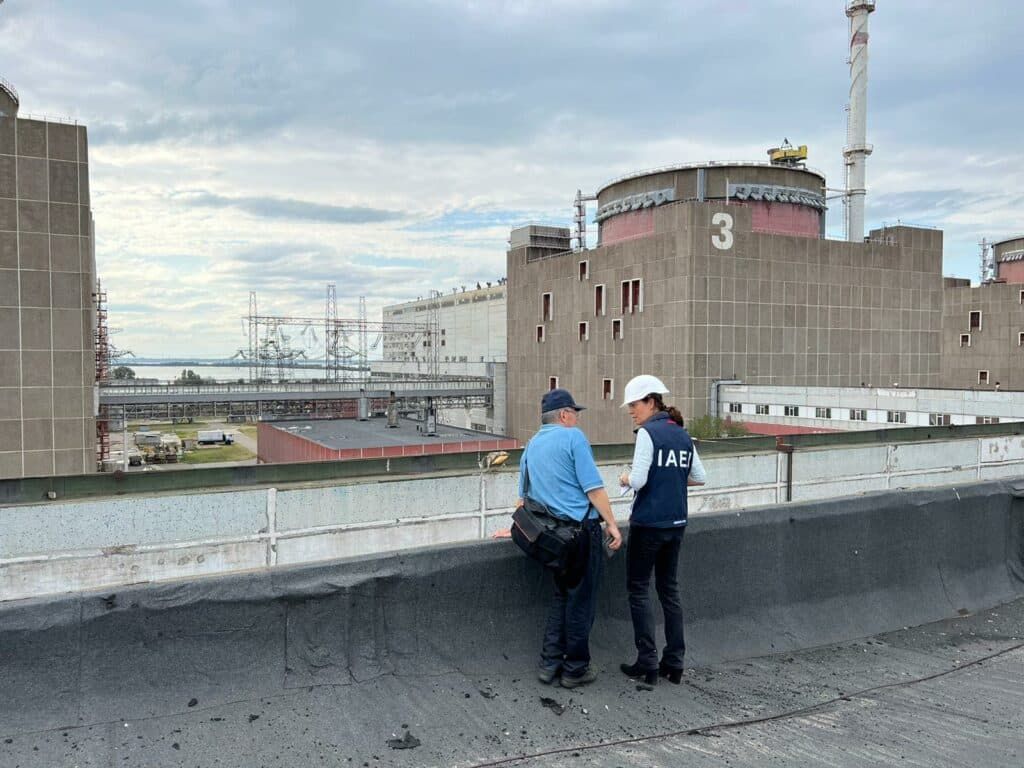Russian actions at Zaporizhzhia show need for better legal protections of nuclear installations
By Luis Rodriguez, Lauren Sukin | October 28, 2022
 The IAEA Support and Assistance Mission to Zaporizhzhya (ISAMZ) arrived at the Zaporizhzhia nuclear power plant in Ukraine on September 1, 2022. The mission comprised IAEA nuclear safety, security, and safeguards staff. (Photo credit: D. Candano Laris/IAEA)
The IAEA Support and Assistance Mission to Zaporizhzhya (ISAMZ) arrived at the Zaporizhzhia nuclear power plant in Ukraine on September 1, 2022. The mission comprised IAEA nuclear safety, security, and safeguards staff. (Photo credit: D. Candano Laris/IAEA)
Russian forces swarm into Chernobyl, forcing the plant’s operators to work tireless, multi-day shifts with their lives under threat. The Romanian government allocates millions of dollars to quickly produce radiation-blocking iodine pills. Purchases of private, luxury fall-out shelters spike. This is not 1986; it is 2022. Russia’s full-scale invasion of Ukraine has brought back Cold War anxieties, not least of which has been the re-emergence of nuclear fear-mongering and the looming threat of nuclear accidents.
Since early March, Russian forces have shelled and seized the Zaporizhzhia nuclear power plant in southern Ukraine, the largest such plant in Europe and the tenth largest in the world. Russian actions in Zaporizhzhia create a dangerous precedent. To prevent other countries from similarly targeting and attacking nuclear facilities in future conflicts, the international community must improve existing guidelines for their physical protection.
The current international nuclear safeguarding regime focuses on protections against those who might attempt the unauthorized removal of nuclear materials or engage in sabotage actions. Efforts to minimize risks for terrorists and those with insider knowledge of nuclear plants have been front and center in these conversations. But Russia’s actions show the limits of this approach when nuclear facilities are in a war zone. These regulations do little to stop state militaries from acting irresponsibly in and around nuclear plants.
The Russian military attacks on Ukraine’s nuclear power plants show the need for expanded guidelines for the physical protection of nuclear facilities.
Russia’s dangerous precedent. The Russian occupation of the Zaporizhzhia nuclear power plant increases the chances of power outages and human errors or military mistakes. For example, on August 25, operators temporarily disconnected the plant from the power grid for the first time in 40 years. The shelling cut power lines supplying electricity to the plant, causing the automatic shutdown of two reactors. Fighting at and around Zaporizhzhia has been somewhat limited since Russia seized control of the plant. But the consequences of any further military operations at the site could be indiscriminate and expansive. A nuclear accident at the plant—either in one or several of its six reactors or spent fuel storage pools—could trigger a massive release of radioactive substances affecting countries well beyond Ukraine’s borders and bringing back many of the same catastrophic challenges the region has faced since the Chernobyl nuclear disaster in 1986.
The radioactive fallout and subsequent environmental and agricultural impacts from a nuclear accident could affect populations across Europe, not just forces fighting in Ukraine. The situation at the Zaporizhzhia nuclear power plant is a reminder of the expansive nature and scope of existing nuclear risks; it also shows that weaponizing nuclear reactors would present new types of risks. The potential strategic gains of occupying any nuclear power plant will be irrelevant if a large-scale calamity ensues.
Although the chances seem low that Russia will cooperate on updating the nuclear security and safety regime, President Vladimir Putin recently signaled his willingness to re-engage with the United States on arms control. That is an important opportunity the international community should capitalize on by demanding that regulations for the safety of nuclear facilities during wartime be included in any such discussions.
Inadequate stop-gaps. With its unprovoked war in Ukraine, Russia has transgressed a variety international regulations and exploited legal vacuums and ambiguous norms and laws. Moving forward, the security and safety regime of nuclear facilities must be made stronger if it is to avoid situations similar to Zaporizhzhia’s.
Two main conventions currently offer limited protection to nuclear facilities in regard to direct security threats. But these regulations have done little to stymie the Russian attacks on Ukrainian nuclear power plants. The IAEA Convention on the Physical Protection of Nuclear Material and Nuclear Facilities criminalizes offenses related to illicit trafficking and sabotage of nuclear material or nuclear facilities. But this convention does not cover attacks on nuclear power plants by state militaries. Instead, it focuses on the risks to facilities that could come from internal saboteurs or terrorist organizations. Although the guidelines, which prohibit intentional damage to a nuclear facility, would be useful in a state-vs.-state context, there is no legal mechanism to apply them in this way.
Also, the Geneva Conventions of 1949 establish international legal standards for the conduct of warfare. Article 56 of Protocol I to these conventions specifies that “nuclear electrical generating stations” should not be made the object of military attacks. The exception is only when a nuclear plant “provides electric power in regular, significant and direct support of military operations and if such attacks are the only feasible way to terminate such support.” This raises questions about protections for nuclear power generation occurring within military facilities, even though attacks on such reactors could still harm civilians many countries away. In addition, although direct attacks on nuclear power plants producing power primarily for civilians cannot be considered a military target, they could still legally be destroyed if they were near a more legitimate military target. The Geneva Conventions allow militaries to destroy so-called “civilian objects”—such as power plants, homes, and infrastructure—if this destruction occurs as collateral damage when the military attacks a legal target, such as an adversary’s military base. Moreover, the conventions do not protect spent nuclear fuel storage and fuel reprocessing facilities, which, if attacked, would also pose significant risks and potentially widespread contamination. There is also little recourse for violations of the Geneva Conventions.
These regulations have been insufficient to deter or address Russian attacks on nuclear power plants. To the contrary, Russia’s actions in Ukraine have undermined the power of the Geneva Conventions’ restrictions against attacking nuclear facilities. If Russia is not made to face consequences for its actions, other countries may be more willing to mimic its behavior.
Nuclear power production facilities exist in many countries with ongoing conflicts, major international security threats, or civil unrest. These include China, Egypt, Taiwan, India, and Pakistan. Other vulnerable countries—like Sudan, Turkey, Libya, and Venezuela—are pursuing or have openly considered nuclear power programs. Without adequate protections, current and future nuclear facilities represent major international threats, should wars break out near them.
Improve legal protections. There is an increasing and imperative need to create a regime protecting nuclear facilities. This regime should offer protection irrespective of how the energy that the nuclear power plants produce is used—for civilian or military purposes—and irrespective of the type of facility where nuclear material is present. In 2019, the IAEA General Conference recognized the need to prohibit armed attacks and threats against nuclear installations, even though little progress has been made since then. Russia’s actions in Ukraine are a call to speed up these efforts.
The current nuclear security regime could be improved by amending the Treaty on the Non-Proliferation of Nuclear Weapons (NPT) so it includes language prohibiting military targeting of nuclear facilities—broadly defined and under any conditions. Regulations should also be provided to maintain the safety of nuclear facilities in the event that they switch hands following changes in territorial control. These rules should enable International Atomic Energy Agency inspections of nuclear installations on occupied territory, and countries should be bound to IAEA guidelines about shift length, worker treatment, reporting procedures, and other safeguards.
This approach could strengthen the NPT, offer constraints on the behavior of many key international actors, and leverage an existing forum with its own inspection regime (the IAEA) and accountability mechanisms (provisions for sanctions).
However, any amendment to the current safeguards would face an uphill journey. In August, Russia blocked the adoption of the outcome document of the 10th Review Conference of the Parties to the NPT, citing the proposed inclusion of language noting concerns about nuclear safety matters at Zaporizhzhia.
The Russian invasion of Ukraine is not the first instance of a conflict involving two countries with nuclear installations. But, despite tensions, India and Pakistan have created legal protections for their nuclear facilities should a conflict break out. In 1988, the two foreign secretaries signed the India-Pakistan Non-Attack Agreement, which prohibits “undertaking, encouraging, or participating in, directly or indirectly, any action aimed at causing destruction or damage to any nuclear installation or facility in each country.” The Indo-Pakistani mechanism to manage nuclear risk offers an example of regulations that effectively promote the physical protection of nuclear facilities. This bilateral treaty could provide a partial blueprint for a path forward by including its language prohibiting indirect attacks on nuclear facilities in any future multilateral regime.
Update the regime. Russian attacks on the Zaporizhzhia nuclear power plant set a dangerous precedent. An accident in a nuclear power plant would lead to immense environmental consequences. The safety and security protection of nuclear power plants should just be the beginning. As the Bulletin recently reported, damage to industrial and power facilities—be it from climate change or warfare—could have dramatic consequences the world over.
The unambiguous legal prohibition against targeting or attacking nuclear power plants could prevent future aggressions. Clear standards would prevent the normalization of such attacks, at least by denying countries the possibility to justify their use of force. Putin, for example, has claimed the legality of his actions in Ukraine, purposefully using the scarcity of regulations in his favor.
Setting new rules and norms protecting nuclear facilities alone will not trigger automatic enforcement. But it would unambiguously delegitimize this type of action. The inclusion of a prohibition against any attack—direct or indirect—would mitigate some of the issues with the Geneva Conventions’ permissions for collateral damage and underscore the importance of avoiding nuclear accidents, even when there may be military advantage at play.
Together, we make the world safer.
The Bulletin elevates expert voices above the noise. But as an independent nonprofit organization, our operations depend on the support of readers like you. Help us continue to deliver quality journalism that holds leaders accountable. Your support of our work at any level is important. In return, we promise our coverage will be understandable, influential, vigilant, solution-oriented, and fair-minded. Together we can make a difference.

















Laws are violated in wars. Wars will happen again and again. The lesson of the Ukraine war is that all nuclear power plants should be shut down and no others built. And, of course, the 9 nuclear weapon-owning countries should meet and agree to abolish nuclear weapons.